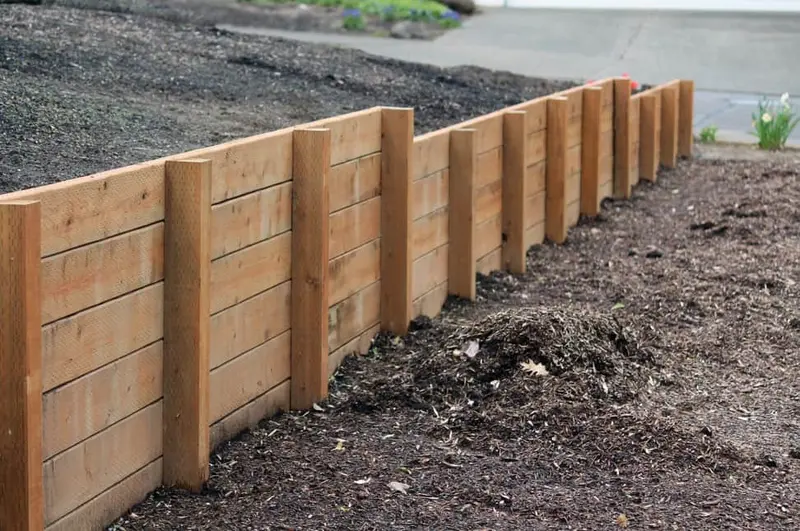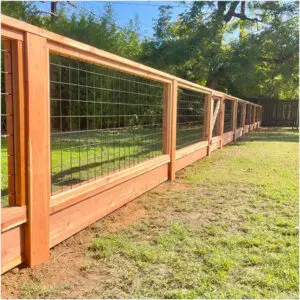Retaining walls are an integral part of any landscaping project. They not only help to define the borders of a property, but they provide an aesthetically pleasing way to add structure and formality to a garden or yard. Pressure treated wood retaining walls are becoming increasingly popular due to their unique look and affordable price compared to brick or stone. In this blog post, we will explore everything you need to know about pressure treated wood retaining walls, from installation techniques to maintenance tips and more. Read on for all the information you need for your next DIY project!
What Is Pressure Treated Wood?
Pressure-treated wood is lumber that has been infused with chemical preservatives to protect the wood from rot, insects, and other decay. The chemicals used to preserve the wood have been changing over the last few years to make them more ecologically friendly and safe.
Prior to 2004 pressure treated wood was most commonly southern yellow pine and was treated with chromated copper arsenate (CCA). However in 2004, the EPA passed a law that that Arsenate must be removed from the chemical composition used in the pressure treating process . CCA-treated wood is no longer produced or sold in the United States due to health and environmental concerns. While it had been used for decades for a variety of outdoor applications, including decks, playground equipment, and fences it was no longer allowed.
Today pressure treated wood we most commonly find is fir wood and it is treated with other chemicals, such as alkaline copper quaternary (ACQ), copper azole (CA), and ammoniacal copper quaternary (ACQD). There are 2 types of fir that are used in our area and one is better than the other, but is harder to find.
– HEMP Fir Treated – It is easier to find on the market and it costs just a little less than Douglas fir, it does have its downsides. We have found that it does not last as long and rots out quicker than the more durable Douglas Fir treated options. Also this hemp fir option has a greater probability of bowing and twisting.
– DOUGLAS Fir Treated – This is the choice treated lumber to use because of its extended durability and stability against bowing and twisting. While it sounds the same “fir” it really is much better than some of the other woods out there.
There are many advantages to pressure treated wood, especially when it comes to retaining walls. Pressure treated wood is rot and insect resistant, which means it will last longer than untreated wood. It is also more durable and less likely to warp or crack over time.
Why Do People Choose Wood?
Pressure treated wood retaining walls are one of the most popular choices for home and business owners who need to retain some dirt in their yard or who have a grade difference between them and their neighbor. Not only do they look great, but pressure treated wood retaining walls are also very durable and require little maintenance.
If you’re thinking about adding a pressure treated wood retaining wall to your property, there are a few things you should know before getting started. First, it’s important to choose the right type of wood for your project. Pressure treated lumber is available in several different grades, so be sure to select the grade that best suits your needs – it will usually be available in Premium down to Grade 3, with cost and quality implications for each grade in between.
When it comes to installing your wood retaining wall, people tend to opt for hot dipped galvanized nails or screws to avoid rusting and staining. We recommend hot dipped galvanized nails which have a thicker protection coating versus electro galvanized nails which tend to fail sooner due to a thinner coating.
How to Prepare for a Treated Wood Retaining Wall
If you’re looking to build a pressure treated wood retaining wall, there are a few things you’ll need to know before getting started. Here’s a detailed guide on how to prepare for a pressure treated wood retaining wall:
- Choose the right location for your retaining wall. It’s important to choose a spot that doesn’t have any underground utilities or other obstacles that could make building your retaining wall more difficult.
- Once you’ve chosen the perfect location for your retaining wall, it’s important to call 811 so that any underground utilities can be marked and avoided during construction.
- Clear the area where your retaining wall will be built. Be sure to remove any debris, rocks, or other objects from the area where your retaining wall will be constructed. This will help ensure that your wall is built on level ground.
- Space out and set your pressure treated wood posts in concrete every 4 foot on center. . These posts are the structural foundation that will hold the retained dirt in place so focussing on getting these set deep and straight is very important. Setting these posts 4 foot on center is important because this helps keep the treated wood from bowing out under the pressure of the dirt that it will be retaining.
- Install the first course of retaining wood. The first course of timbers should be installed using galvanized nails or screws driven through the face of each timber into the one behind it. Be sure that all the horizontal railsare level as you install them.
How Long Do Pressure Treated Wood Retaining Walls Last?
Untreated wood retaining walls (without a fence attached) are usually expected to last for around 20 years, but when they are built from high quality pressure treated wood, it’s not unusual for them to last 30 years or more.
It’s not quite as long as stone, brick, or masonry walls, but wood is a lot more affordable and stylish. We think this makes it a great option for most applications.
To ensure that your pressure treated wood retaining wall lasts for many years, it is important to have it installed by a professional if possible. Subsequently, you should inspect your wall regularly and make sure that it is free of cracks or other damage. If you notice any damage, you should have it repaired immediately to prevent further deterioration. This will ensure you get maximum lifespan out of your new timber wall.
Maintenance of Pressure Treated Wood Retaining Walls
It’s important to maintain a new wall properly in order to ensure its longevity. Here are some tips for maintaining your pressure treated wood retaining wall:
- Inspect your wall regularly for any damage or cracks. If you notice any damage, repair it immediately to prevent further deterioration.
- If you have plants growing near your retaining wall, make sure to trim them regularly. Overgrown plants or root systems can damage the structure of the wall and cause it to crack or collapse.
- Make sure the ground around your retaining wall is well-drained. This is very important because excess moisture can cause the wood to rot and break down over time. This moisture if the number 1 reason we see retaining walls fail over time.
- If you live in an area with extreme weather conditions (e.g., severe cold or heat), take measures to protect your retaining wall from these conditions. For example, if it gets very cold where you live, consider adding insulation to your retaining wall to prevent the wood from freezing and cracking.
By following these simple tips, you can help extend the life of your pressure treated wood retaining wall and keep it looking its best for years to come!
How Much Do Pressure Treated Wood Retaining Walls Cost?
The average cost of a pressure-treated wood retaining wall is between $35 and $60 per linear foot for a professionally installed, high quality wall. The cost will vary depending on the size and complexity of the project.
This would mean that a 50’ wall project would cost you $1,750 – $3,000
Are Pressure Treated Wood Retaining Walls Safe?
The short answer is yes, pressure treated wood retaining walls are safe in your yard. The chemicals used to treat the lumber on the market today are not harmful to humans or animals.
However, there are a few things to keep in mind if you are planning on building a pressure treated wood retaining wall. First, the lumber should be rated for ground contact. This means that it has been specifically treated to resist rot and decay when it is in contact with soil. While it will still decay over time, this treatment will help extend the life of your new retaining wall.
You should also be sure to use corrosion-resistant fasteners when attaching the lumber to your wall. Pressure treated lumber can be corrosive, so regular nails and screws may not work as well as they would with regular lumber. Most experts agree that hot dipped galvanized fasteners are the way to go.
Overall, pressure treated wood retaining walls are safe as long as you take proper precautions when installing them. With proper care, your wall should last for many years.
Advantages and Disadvantages of Pressure Treated Wood Retaining Walls
Pressure treated wood is a popular material for retaining walls because it is strong, durable and affordable. However, there are both advantages and disadvantages to using pressure treated wood over other materials.
Advantages:
- Pressure treated wood is very strong and can withstand a lot of weight for the cost
- Pressure treated wood is resistant to rot and insect damage
- It’s much more affordable than other popular materials
- Much easier to install than concrete if you are not experienced in construction
Disadvantages:
- Pressure treated wood won’t last as long as masonry, stone, or brick
- It can require more maintenance than stone or brick
To Sum Up
Pressure treated wood retaining walls offer a great solution for building beautiful and long-lasting retaining walls. With the right tools and materials, you can easily build pressure treated wood retaining walls that will stand up to the elements while adding some aesthetic value to your landscaping.
Be sure to take all safety precautions during construction and use quality materials in order to get the most out of your pressure treated wood retaining wall. Have fun creating this useful addition to your outdoor space!
If you’re looking for a group of reliable professionals to install a wood retaining wall on your property – contact us today! We have years of experience in the industry, and will help find the perfect materials and design for you. We know exactly what it takes to build a high quality timber retaining wall that will have an extremely long lifespan.
Call us at 916-790-7100 and we will be happy to give you a free estimate for your project.




